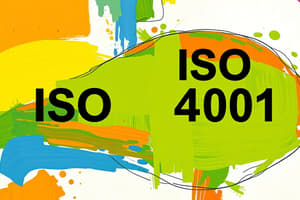Podcast
Questions and Answers
What is a key principle of environmental management that emphasizes proactive actions to avoid pollution?
What is a key principle of environmental management that emphasizes proactive actions to avoid pollution?
- Prevention Approach (correct)
- Sustainable Development
- Continuous Improvement
- Stakeholder Engagement
Which of the following is NOT part of developing an effective environmental policy?
Which of the following is NOT part of developing an effective environmental policy?
- Setting measurable objectives
- Communicating the policy to all stakeholders
- Fostering competition among employees (correct)
- Regularly reviewing and updating the policy
What is the purpose of key performance indicators (KPIs) in an Environmental Management System?
What is the purpose of key performance indicators (KPIs) in an Environmental Management System?
- To assess environmental performance (correct)
- To establish legal requirements
- To enhance stakeholder engagement
- To communicate policy changes
What step should be taken first in the risk assessment process of an EMS?
What step should be taken first in the risk assessment process of an EMS?
Which of the following is a requirement for ensuring compliance within an EMS?
Which of the following is a requirement for ensuring compliance within an EMS?
In which way should an organization approach continuous improvement in their environmental management?
In which way should an organization approach continuous improvement in their environmental management?
What does stakeholder engagement in environmental management entail?
What does stakeholder engagement in environmental management entail?
What is a crucial activity in the monitoring and measurement phase of an EMS?
What is a crucial activity in the monitoring and measurement phase of an EMS?
Flashcards are hidden until you start studying
Study Notes
ISO 14001 Environmental Management System
Principles of Environmental Management
- Sustainable Development: Balancing economic, social, and environmental needs.
- Prevention Approach: Emphasizing proactive measures to prevent pollution.
- Continuous Improvement: Ongoing enhancement of environmental performance.
- Stakeholder Engagement: Involving stakeholders in decision-making processes.
- Compliance: Adhering to legal and other requirements related to environmental impact.
Environmental Policy Development
- Commitment to Environmental Excellence: Establish a clear and concise policy statement.
- Framework for Objectives: Set measurable environmental objectives and targets.
- Communication: Ensure policy is communicated to all employees and stakeholders.
- Review and Update: Regularly revisit and revise the policy to reflect changes in the organization or external environment.
Monitoring and Measurement
- Key Performance Indicators (KPIs): Establish metrics to assess environmental performance.
- Data Collection: Use systematic data collection methods to monitor compliance.
- Internal Audits: Conduct regular audits to evaluate the effectiveness of the EMS.
- Management Review: Review monitoring results at management levels to inform decision-making.
Risk Assessment in EMS
- Identifying Risks: Analyze potential environmental impacts of organizational activities.
- Risk Evaluation: Assess the significance and likelihood of identified risks.
- Control Measures: Implement strategies to mitigate or eliminate environmental risks.
- Regular Review: Continuously reassess risks to adapt to new conditions or information.
Regulatory Compliance and ISO 14001
- Legal Requirements: Ensure compliance with applicable environmental laws and regulations.
- Integration with Compliance Obligations: Align EMS with legal requirements to enhance accountability.
- Documentation: Maintain records to demonstrate compliance and performance.
- Noncompliance Management: Establish procedures for addressing and rectifying noncompliance issues.
Principles of Environmental Management
- Sustainable Development: Focus on balancing the economic, social, and environmental aspects to promote sustainability.
- Prevention Approach: Prioritize proactive strategies to prevent pollution and minimize environmental harm.
- Continuous Improvement: Strive for perpetual enhancement of environmental performance through systematic efforts.
- Stakeholder Engagement: Actively involve relevant stakeholders in the decision-making process to consider diverse perspectives.
- Compliance: Maintain adherence to legal regulations and other environmental requirements to ensure responsible operations.
Environmental Policy Development
- Commitment to Environmental Excellence: Create a precise and focused environmental policy statement outlining the organization's commitment.
- Framework for Objectives: Establish measurable objectives and targets to guide environmental performance improvement.
- Communication: Effectively communicate the environmental policy to all employees and stakeholders for transparency.
- Review and Update: Regularly evaluate and update the environmental policy to align with organizational or external changes.
Monitoring and Measurement
- Key Performance Indicators (KPIs): Set metrics to gauge and assess the organization’s environmental performance and effectiveness.
- Data Collection: Implement systematic methods for data collection to monitor compliance and inform decision-making.
- Internal Audits: Conduct regular internal audits to assess the EMS's performance and identify areas for improvement.
- Management Review: Review monitoring outcomes at management levels to facilitate informed and strategic decision-making.
Risk Assessment in EMS
- Identifying Risks: Conduct thorough analysis to identify potential environmental impacts arising from organizational activities.
- Risk Evaluation: Evaluate the significance and likelihood of identified risks to prioritize mitigation efforts.
- Control Measures: Develop and implement strategies designed to mitigate or eliminate environmental risks effectively.
- Regular Review: Continuously reassess risks to stay responsive to new information or changing circumstances.
Regulatory Compliance and ISO 14001
- Legal Requirements: Ensure all activities comply with applicable environmental laws and regulations to uphold legal standards.
- Integration with Compliance Obligations: Align the Environmental Management System (EMS) with legal requirements for enhanced accountability.
- Documentation: Maintain comprehensive records to demonstrate compliance and track environmental performance.
- Noncompliance Management: Establish structured procedures for identifying, addressing, and rectifying instances of noncompliance.
Studying That Suits You
Use AI to generate personalized quizzes and flashcards to suit your learning preferences.




